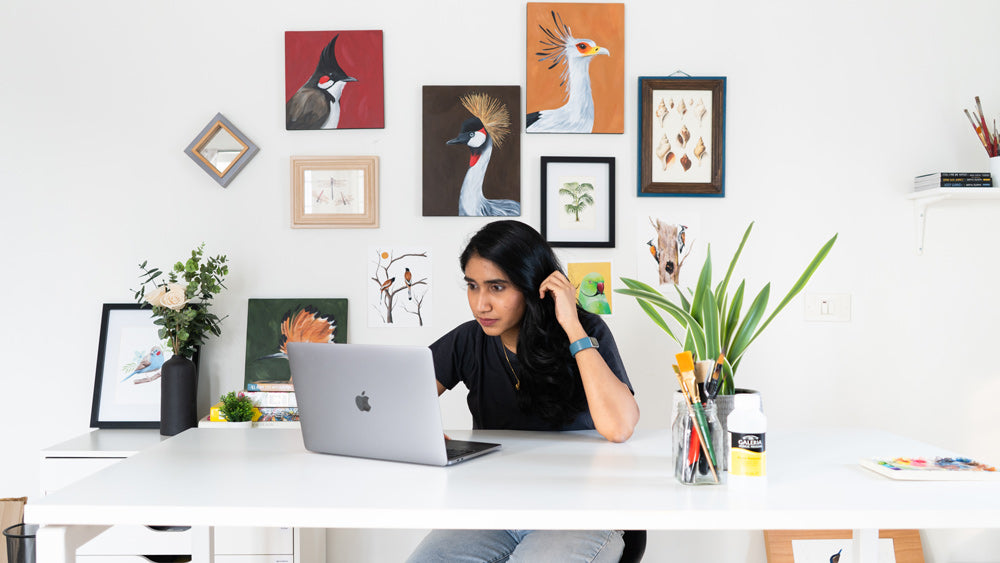Productivity for artists: How to manage your time and avoid burnout

Share
Life as an artist is a delicate balance between inspiration and organisation, spontaneity and structure. While the word productivity might sound a bit sore, I’ve realised that as an artist, being productive with my time has helped me improve my creativity because it gives me the headspace I need to get into the zone and stay with my creativity and art without distractions.
Here are 7 things I tried that helped me be more productive with my time and therefore make time for my creativity:
Planning my weeks in a goal-oriented manner and NOT a task-oriented manner
Here’s how I go about this - I take a step back and think about what are the goals I want to achieve this year. I then break that down into quarters, this way I end up with 2-3 goals a quarter. I further break this down to months, which will leave me with 1 or max 2 goals a month. Now when I plan my weeks, they will be to move the needle towards achieving these 1 or 2 goals.
This method makes all my tasks a means to achieve my goal and not just a list of things to check off at the end of the day! It gave me both structure and a more sustainable sense of accomplishment.
Give each day of the week a theme or focus
For example, Monday and Friday are my CEO days. On these days I do all the admin tasks like emails, research, strategy, etc. Tuesdays are my art days where I either paint, learn a new technique, or just practice. Wednesdays are my content days. This is when I plan, record and edit videos, create blogs, social media posts, etc. Thursday is my client day and that’s the day I get anything that requires client interactions, including my weekly newsletters, done.
This gives me one thing to focus on per day and not jump from one content to another. Even if I have 2-3 tasks for Wednesday, all these tasks will focus on content creation, thereby giving me fewer opportunities to deviate or get distracted. Mind you, context switching is not only time-consuming because it takes a while to tune into that headspace to do a task that is completely unrelated to the previous one, but it’s also exhausting on the mind.
No more than 3 tasks a day
By having less to do in a day, I am able to take my time to do those few tasks and I realised that I was able to do them very well. This exercise also helped me consistently end my days with a sense of accomplishment.
(Realistic) Time Blocking
This productivity technique involves dividing your day into distinct blocks of time, each dedicated to a specific task or type of activity. I keep a daily planner that’s split hourly and I block time in pencil so that I can erase and adjust when required.
By assigning focused intervals to various aspects of your creative business, you not only gain a structured framework for your day that adapts to the unique demands of your creative process but also frees up the headspace for concentration and uninterrupted creative flow.
Pareto Principle
The Pareto Principle, often referred to as the 80/20 rule, suggests that roughly 80% of effects come from 20% of causes. As an Artist, by identifying and prioritising the 20% of tasks or efforts that yield 80% of the desired results, I could streamline my goals and tasks so that I was allocating most of my time and energy where it truly mattered.
This also helped me reduce the amount of time spent or find simpler ways to achieve the tasks that took more time but yielded lesser results.
Parkinson’s law
This law states that the more time we allocate to a task, the more time it tends to consume, often without proportional increases in productivity. So you allot a realistic amount of time to complete a task and complete it to the best of your ability within that time. For me, this works particularly well for tasks like checking and replying to emails, creating newsletters, content strategy, editing, etc.
Recognizing that tasks can inflate to fit the time allotted will allow you to set realistic deadlines and create a sense of urgency that drives you to focus and be more efficient.
Be kind to yourself
It’s SO easy to go on a spiral and beat yourself up for not doing enough. Not only does this leave you feeling horrible but it also blocks you from doing what you want to do or have to do. If you are not able to complete all your tasks, develop the mental strength to look back and recognise what you have accomplished and be able to step away from work and step back in after a reasonable break or rest.
This will help you be more motivated, consistent, and appreciative of your accomplishments and honestly just feel good about yourself.
Creativity requires a lot of discipline and consistency to be able to show up on a blank canvas and turn it into something beautiful and meaningful. While it’s tempting to say I will do it when I feel like it or when the time feels right, being productive and mindful with your time will help you create that time and headspace to “feel like it” and actually have the time to let that feeling translate into your work of art!
